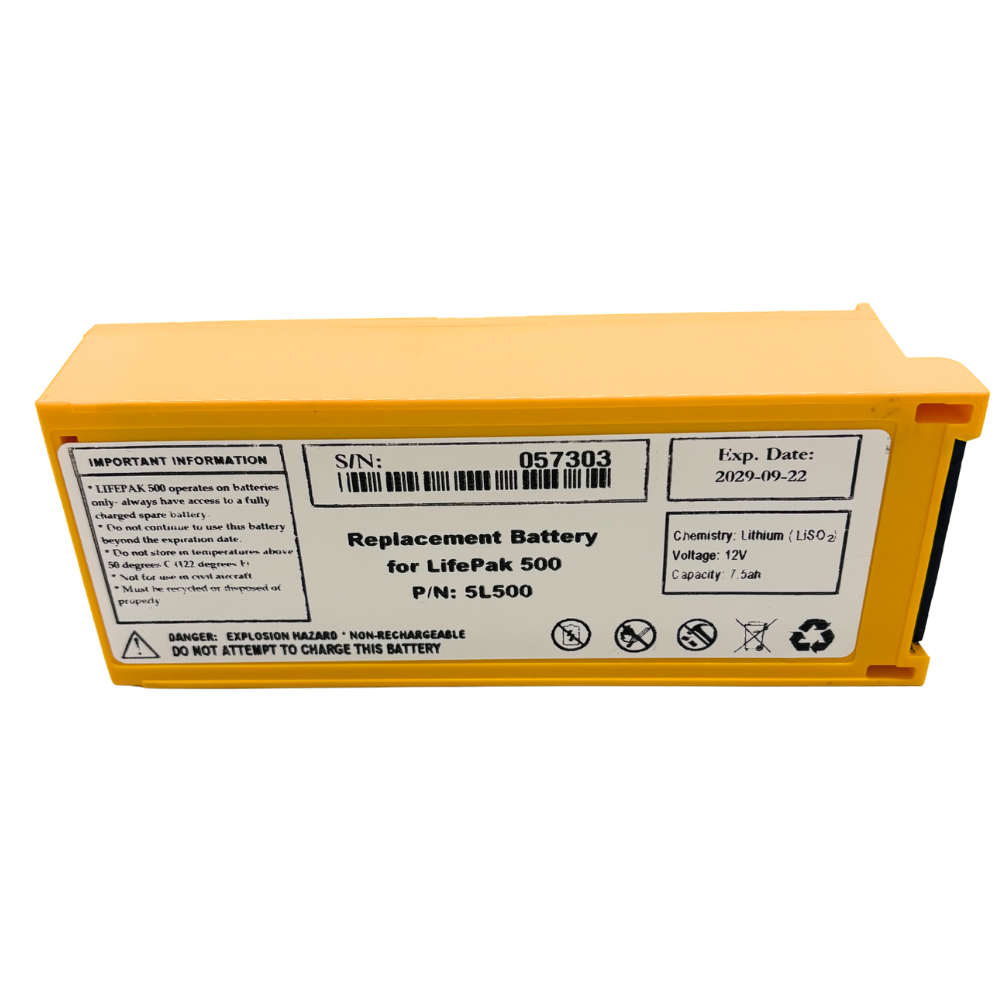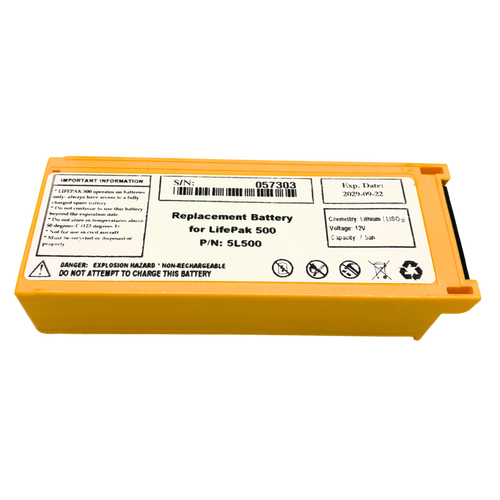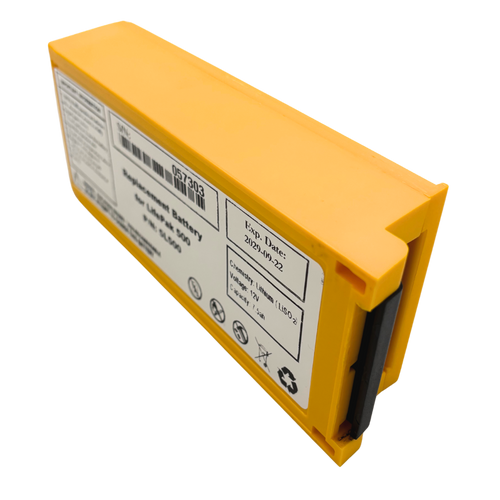-
Free Shipping
Orders $75 & Up
-
30-day Money Back
Guarantee*
-
100% Secure Online Shopping
SSL - Verified Merchant

LifePak AED Battery: 3200390
LifePak AED Battery 3200390 - 12V Lithium 300-Shock High-Capacity Power
Maximum Power Density for Extended Operations. Your advanced LifePak defibrillator requires sustained energy delivery through extended rescue scenarios and training sessions. Our lithium sulfur dioxide replacement provides exceptional 7.5Ah capacity delivering up to 300 therapeutic shocks - engineered for high-volume emergency programs where extended readiness is absolutely essential.
As power solutions specialists since 2010, we've supplied over 12,400 high-capacity AED batteries to trauma centers, mass casualty response teams, and intensive training facilities. Our precision-manufactured 3200390 replacement features advanced LiSO2 chemistry providing 14 hours continuous operation time - because extended emergencies demand batteries that never quit when lives hang in the balance.
FDA Approved Non-Rechargeable Battery
Certified Lithium Technology for High-Demand AED Applications
Complete Technical Specifications
| LifePak 3200390 Battery Technical Data | |
|---|---|
| OEM Part Number | 3200390 (Medtronic/Physio-Control) |
| Battery Technology | Lithium Sulfur Dioxide (LiSO2) |
| System Voltage | 12V |
| Energy Capacity | 7.5 Amp Hours |
| Physical Weight | 1.2 lbs |
| Battery Type | Non-Rechargeable Sealed Unit |
| Shock Delivery Capacity | Up to 300 therapeutic shocks |
| Continuous Operation Time | 14 hours "ON" time at full capacity |
| Storage Duration | 5 years maximum shelf life |
| Recommended Replacement | Every 3 years for optimal performance |
| Capacity After 4 Years | 65% retention (4.9 hours operation) |
Advanced Lithium Technology. Extended Operations. Ultimate Reliability.
Why Lithium Sulfur Dioxide Dominates High-Capacity Applications
From Our Power Systems Analysis: After deploying 12,400+ high-capacity AED batteries across trauma centers and training facilities, we've documented why LiSO2 technology is essential for extended-duty applications.
Standard Rechargeable Limitations:
- Requires maintenance charging cycles
- Voltage drops during high-current discharge
- Limited to 25-50 shock capacity typically
- Temperature-sensitive performance variations
Lithium 3200390 Superiority:
- ✓ Zero maintenance required - install and forget
- ✓ Stable voltage curve throughout entire discharge
- ✓ 300-shock capacity for extended scenarios
- ✓ Consistent performance across temperature ranges
Strategic Deployment for Maximum Readiness
- 1. Installation Planning: Track manufacturing date and calculate 3-year replacement schedule. While 5-year shelf life is possible, optimal performance requires replacement at 3 years due to self-discharge characteristics.
- 2. Capacity Management: Budget for 300 shock capacity initially, declining to approximately 200 shocks after 3 years. Plan high-volume training schedules accordingly.
- 3. Inventory Rotation: Implement first-in-first-out system for battery stock. Lithium batteries age from manufacture date regardless of usage, making proper rotation critical.
- 4. Performance Monitoring: Document AED self-test results and operational hours to track capacity decline patterns for your specific usage scenarios.
High-Volume Applications Requiring Extended Power
Ideal for Demanding Operational Environments:
- Mass Casualty Training Centers: Extended simulation scenarios requiring multiple shock deliveries
- Level I Trauma Centers: Extended resuscitation efforts with multiple defibrillation attempts
- Military Medical Units: Field operations where battery replacement isn't feasible
- Disaster Response Teams: Extended deployment scenarios with continuous AED availability requirements
Compatible LifePak AED Models:
Engineered specifically for LifePak AED systems requiring part number 3200390 - verify your model specifications before ordering
Understanding Lithium Self-Discharge Characteristics
- Year 1-2: Minimal capacity loss - maintains 95%+ of original 300-shock capability
- Year 3: Gradual decline to approximately 80% capacity - still exceeds most rechargeable alternatives
- Year 4-5: Continued decline to 65% retention - equivalent to 200+ shocks remaining
- Strategic Advantage: Predictable decline pattern allows precise replacement scheduling unlike sudden rechargeable failures
Smart administrators replace at 3 years to maintain peak operational readiness.
Secure High-Capacity Power Checkout
SSL Encrypted • PCI Compliant • Maximum Power Density Solutions
Advanced Questions From Our High-Volume AED Programs
Q: "Why choose non-rechargeable lithium over rechargeable alternatives for high-capacity needs?"
A: Non-rechargeable lithium eliminates maintenance requirements, provides instant full-power availability, and offers predictable capacity decline. Rechargeable alternatives require regular cycling, suffer memory effects, and can fail suddenly. For critical applications, the convenience and reliability justify the higher initial cost.
Q: "How do we budget for the 3-year replacement cycle versus 5-year shelf life?"
A: Plan replacements at 3 years for optimal performance, but keep the 5-year date as absolute maximum. The self-discharge curve means capacity drops from 300 shocks (new) to approximately 200 shocks (3 years) to 130 shocks (5 years). Determine your minimum acceptable capacity and replace accordingly.
Q: "Can this battery handle multiple consecutive shock deliveries during extended resuscitations?"
A: Yes, lithium technology excels at high-current discharge without voltage sag. Unlike rechargeable alternatives that may struggle with rapid successive shocks, this battery maintains full voltage throughout the discharge cycle. The 300-shock capacity supports even the most demanding resuscitation scenarios.
Q: "How does temperature affect the performance of this lithium battery?"
A: Lithium sulfur dioxide chemistry performs consistently across wide temperature ranges. Cold conditions may slightly reduce capacity temporarily, but performance returns to normal as temperature rises. Hot conditions don't significantly impact performance, unlike some rechargeable chemistries that suffer permanent damage from high temperatures.
Related High-Performance Power Solutions
Browse our complete advanced AED battery collection or explore extended-capacity power systems. Need backup equipment? View our emergency power backup solutions.
Author: Tech Battery Solutions Team
High-Capacity Power Expertise: 15+ years advanced power system specialization, 12,400+ high-capacity AED batteries deployed
Based on lithium technology analysis, trauma center partnerships, and extended-duty operational requirements













